Loco-Regional Treatment of the Primary Tumor in De Novo Metastatic Breast Cancer Patients Undergoing Front-Line Chemotherapy
Abstract
Simple Summary
Abstract
1. Introduction
2. Materials and Methods
2.1. Study Design
2.2. Stratification Factors and Definitions of Long-Term Oncological Outcomes
2.3. Statistical Analysis
3. Results
3.1. Study Population
3.2. Impact of Loco-Regional Treatment on Long-Term Oncological Outcomes and Subgroup Analyses
4. Discussion
5. Conclusions
Author Contributions
Funding
Institutional Review Board Statement
Informed Consent Statement
Data Availability Statement
Conflicts of Interest
References
- Lobbezoo, D.J.A.; Van Kampen, R.J.W.; Voogd, A.C.; Dercksen, M.W.; Van Den Berkmortel, F.; Smilde, T.J.; Van De Wouw, A.J.; Peters, F.P.J.; Van Riel, J.M.G.H.; Peters, N.A.J.B.; et al. Prognosis of Metastatic Breast Cancer Subtypes: The Hormone Receptor/HER2-Positive Subtype Is Associated with the Most Favorable Outcome. Breast Cancer Res. Treat. 2013, 141, 507–514. [Google Scholar] [CrossRef] [PubMed]
- den Brok, W.D.; Speers, C.H.; Gondara, L.; Baxter, E.; Tyldesley, S.K.; Lohrisch, C.A. Survival with Metastatic Breast Cancer Based on Initial Presentation, de Novo versus Relapsed. Breast Cancer Res. Treat. 2017, 161, 549–556. [Google Scholar] [CrossRef] [PubMed]
- AlSendi, M.; O’Reilly, D.; Zeidan, Y.H.; Kelly, C.M. Oligometastatic Breast Cancer: Are We There Yet? Int. J. Cancer 2021, 149, 1520–1528. [Google Scholar] [CrossRef]
- Gradishar, W.J.; Moran, M.S.; Abraham, J.; Aft, R.; Agnese, D.; Allison, K.H.; Anderson, B.; Burstein, H.J.; Chew, H.; Dang, C.; et al. Breast Cancer, Version 3.2022. JNCCN J. Natl. Compr. Cancer Netw. 2022, 20, 691–722. [Google Scholar] [CrossRef] [PubMed]
- O’Shaughnessy, J.; Petrakova, K.; Sonke, G.S.; Conte, P.; Arteaga, C.L.; Cameron, D.A.; Hart, L.L.; Villanueva, C.; Jakobsen, E.; Beck, J.T.; et al. Ribociclib plus Letrozole versus Letrozole Alone in Patients with de Novo HR+, HER2− Advanced Breast Cancer in the Randomized MONALEESA-2 Trial. Breast Cancer Res. Treat. 2018, 168, 127–134. [Google Scholar] [CrossRef]
- Hortobagyi, G.N.; Stemmer, S.M.; Burris, H.A.; Yap, Y.-S.; Sonke, G.S.; Paluch-Shimon, S.; Campone, M.; Blackwell, K.L.; André, F.; Winer, E.P.; et al. Ribociclib as First-Line Therapy for HR-Positive, Advanced Breast Cancer. N. Engl. J. Med. 2016, 375, 1738–1748. [Google Scholar] [CrossRef]
- Finn, R.S.; Martin, M.; Rugo, H.S.; Jones, S.; Im, S.-A.; Gelmon, K.; Harbeck, N.; Lipatov, O.N.; Walshe, J.M.; Moulder, S.; et al. Palbociclib and Letrozole in Advanced Breast Cancer. N. Engl. J. Med. 2016, 375, 1925–1936. [Google Scholar] [CrossRef]
- Corona, S.P.; Sobhani, N.; Ianza, A.; Roviello, G.; Mustacchi, G.; Bortul, M.; Zanconati, F.; Generali, D. Advances in Systemic Therapy for Metastatic Breast Cancer: Future Perspectives. Med. Oncol. 2017, 34, 119. [Google Scholar] [CrossRef]
- Sánchez-Muñoz, A.; Pérez-Ruiz, E.; Ribelles, N.; Márquez, A.; Alba, E. Maintenance Treatment in Metastatic Breast Cancer. Expert Rev. Anticancer Ther. 2008, 8, 1907–1912. [Google Scholar] [CrossRef]
- Pons-Tostivint, E.; Kirova, Y.; Lusque, A.; Campone, M.; Geffrelot, J.; Mazouni, C.; Mailliez, A.; Pasquier, D.; Madranges, N.; Firmin, N.; et al. Survival Impact of Locoregional Treatment of the Primary Tumor in De Novo Metastatic Breast Cancers in a Large Multicentric Cohort Study: A Propensity Score-Matched Analysis. Ann. Surg. Oncol. 2019, 26, 356–365. [Google Scholar] [CrossRef]
- Hazard, H.W.; Gorla, S.R.; Scholtens, D.; Kiel, K.; Gradishar, W.J.; Khan, S.A. Surgical Resection of the Primary Tumor, Chest Wall Control, and Survival in Women with Metastatic Breast Cancer. Cancer 2008, 113, 2011–2019. [Google Scholar] [CrossRef]
- Demicheli, R.; Retsky, M.W.; Swartzendruber, D.E.; Bonadonna, G. Proposal for a New Model of Breast Cancer Metastatic Development. Ann. Oncol. 1997, 8, 1075–1080. [Google Scholar] [CrossRef]
- Marks, C.E.; Thomas, S.M.; Fayanju, O.M.; DiLalla, G.; Sammons, S.; Hwang, E.S.; Plichta, J.K. Metastatic Breast Cancer: Who Benefits from Surgery? Am. J. Surg. 2022, 223, 81–93. [Google Scholar] [CrossRef] [PubMed]
- Lin, Y.; Huang, K.; Zeng, Q.; Zhang, J.; Song, C. Impact of Breast Surgery on Survival of Patients with Stage IV Breast Cancer: A SEER Population-Based Propensity Score Matching Analysis. PeerJ 2020, 8, e8694. [Google Scholar] [CrossRef] [PubMed]
- Wu, Q.; Li, J.; Zhu, S.; Wu, J.; Chen, C.; Liu, Q.; Wei, W.; Zhang, Y.; Sun, S. Breast Cancer Subtypes Predict the Preferential Site of Distant Metastases: A SEER Based Study. Oncotarget 2017, 8, 27990–27996. [Google Scholar] [CrossRef] [PubMed]
- Harris, E.; Barry, M.; Kell, M.R. Meta-Analysis to Determine If Surgical Resection of the Primary Tumour in the Setting of Stage IV Breast Cancer Impacts on Survival. Ann. Surg. Oncol. 2013, 20, 2828–2834. [Google Scholar] [CrossRef]
- Petrelli, F.; Barni, S. Surgery of Primary Tumors in Stage IV Breast Cancer: An Updated Meta-Analysis of Published Studies with Meta-Regression. Med. Oncol. 2012, 29, 3282–3290. [Google Scholar] [CrossRef] [PubMed]
- Badwe, R.; Hawaldar, R.; Nair, N.; Kaushik, R.; Parmar, V.; Siddique, S.; Budrukkar, A.; Mittra, I.; Gupta, S. Locoregional Treatment versus No Treatment of the Primary Tumour in Metastatic Breast Cancer: An Open-Label Randomised Controlled Trial. Lancet Oncol. 2015, 16, 1380–1388. [Google Scholar] [CrossRef]
- Soran, A.; Ozmen, V.; Ozbas, S.; Karanlik, H.; Muslumanoglu, M.; Igci, A.; Canturk, Z.; Utkan, Z.; Ozaslan, C.; Evrensel, T.; et al. Randomized Trial Comparing Resection of Primary Tumor with No Surgery in Stage IV Breast Cancer at Presentation: Protocol MF07-01. Ann. Surg. Oncol. 2018, 25, 3141–3149. [Google Scholar] [CrossRef]
- Wolff, A.C.; McShane, L.M.; Hammond, M.E.H.; Allison, K.H.; Fitzgibbons, P.; Press, M.F.; Harvey, B.E.; Mangu, P.B.; Bartlett, J.M.S.; Hanna, W.; et al. Human Epidermal Growth Factor Receptor 2 Testing in Breast Cancer: American Society of Clinical Oncology/College of American Pathologists Clinical Practice Guideline Focused Update. Arch. Pathol. Lab. Med. 2018, 142, 1364–1382. [Google Scholar] [CrossRef]
- Schwartz, L.H.; Litière, S.; De Vries, E.; Ford, R.; Gwyther, S.; Mandrekar, S.; Shankar, L.; Bogaerts, J.; Chen, A.; Dancey, J.; et al. RECIST 1.1—Update and Clarification: From the RECIST Committee. Eur. J. Cancer 2016, 62, 132–137. [Google Scholar] [CrossRef]
- Lane, W.O.; Thomas, S.M.; Blitzblau, R.C.; Plichta, J.K.; Rosenberger, L.H.; Fayanju, O.M.; Hyslop, T.; Hwang, E.S.; Greenup, R.A. Surgical Resection of the Primary Tumor in Women with De Novo Stage IV Breast Cancer: Contemporary Practice Patterns and Survival Analysis. Ann. Surg. 2019, 269, 537–544. [Google Scholar] [CrossRef] [PubMed]
- Arnedos, M.; Vicier, C.; Loi, S.; Lefebvre, C.; Michiels, S.; Bonnefoi, H.; Andre, F. Precision Medicine for Metastatic Breast Cancer-Limitations and Solutions. Nat. Rev. Clin. Oncol. 2015, 12, 693–704. [Google Scholar] [CrossRef] [PubMed]
- Khan, S.A.; Stewart, A.K.; Morrow, M. Does Aggressive Local Therapy Improve Survival in Metastatic Breast Cancer? Surgery 2002, 132, 620–627. [Google Scholar] [CrossRef] [PubMed]
- Gnerlich, J.; Jeffe, D.B.; Deshpande, A.D.; Beers, C.; Zander, C.; Margenthaler, J.A. Surgical Removal of the Primary Tumor Increases Overall Survival in Patients with Metastatic Breast Cancer: Analysis of the 1988–2003 SEER Data. Ann. Surg. Oncol. 2007, 14, 2187–2194. [Google Scholar] [CrossRef]
- Rapiti, E.; Verkooijen, H.M.; Vlastos, G.; Fioretta, G.; Neyroud-Caspar, I.; Sappino, A.P.; Chappuis, P.O.; Bouchardy, C. Complete Excision of Primary Breast Tumor Improves Survival of Patients with Metastatic Breast Cancer at Diagnosis. J. Clin. Oncol. 2006, 24, 2743–2749. [Google Scholar] [CrossRef] [PubMed]
- Vohra, N.A.; Brinkley, J.; Kachare, S.; Muzaffar, M. Primary Tumor Resection in Metastatic Breast Cancer: A Propensity-Matched Analysis, 1988-2011 SEER Data Base. Breast J. 2018, 24, 549–554. [Google Scholar] [CrossRef] [PubMed]
- Babiera, G.V.; Rao, R.; Feng, L.; Meric-Bernstam, F.; Kuerer, H.M.; Singletary, S.E.; Hunt, K.K.; Ross, M.I.; Gwyn, K.M.; Feig, B.W.; et al. Effect of Primary Tumor Extirpation in Breast Cancer Patients Who Present with Stage IV Disease and an Intact Primary Tumor. Ann. Surg. Oncol. 2006, 13, 776–782. [Google Scholar] [CrossRef]
- Dominici, L.; Najita, J.; Hughes, M.; Niland, J.; Marcom, P.; Wong, Y.N.; Carter, B.; Javid, S.; Edge, S.; Burstein, H.; et al. Surgery of the Primary Tumor Does Not Improve Survival in Stage IV Breast Cancer. Breast Cancer Res. Treat. 2011, 129, 459–465. [Google Scholar] [CrossRef]
- Cady, B.; Nathan, N.R.; Michaelson, J.S.; Golshan, M.; Smith, B.L. Matched Pair Analyses of Stage IV Breast Cancer with or without Resection of Primary Breast Site. Ann. Surg. Oncol. 2008, 15, 3384–3395. [Google Scholar] [CrossRef]
- Lim, B.; Hortobagyi, G.N. Current Challenges of Metastatic Breast Cancer. Cancer Metastasis Rev. 2016, 35, 495–514. [Google Scholar] [CrossRef] [PubMed]
- King, T.A.; Lyman, J.; Gonen, M.; Reyes, S.; Hwang, E.-S.S.; Rugo, H.S.; Liu, M.C.; Boughey, J.C.; Jacobs, L.K.; McGuire, K.P.; et al. A Prospective Analysis of Surgery and Survival in Stage IV Breast Cancer (TBCRC 013). J. Clin. Oncol. 2016, 34, 1006. [Google Scholar] [CrossRef]
- Fitzal, F.; Bjelic-Radisic, V.; Knauer, M.; Steger, G.; Hubalek, M.; Balic, M.; Singer, C.; Bartsch, R.; Schrenk, P.; Soelkner, L.; et al. Impact of Breast Surgery in Primary Metastasized Breast Cancer: Outcomes of the Prospective Randomized Phase III ABCSG-28 POSYTIVE Trial. Ann. Surg. 2019, 269, 1163–1169. [Google Scholar] [CrossRef] [PubMed]
- Amabile, M.I.; Frusone, F.; De Luca, A.; Tripodi, D.; Imbimbo, G.; Lai, S.; D’andrea, V.; Sorrenti, S.; Molfino, A. Locoregional Surgery in Metastatic Breast Cancer: Do Concomitant Metabolic Aspects Have a Role on the Management and Prognosis in This Setting? J. Pers. Med. 2020, 10, 227. [Google Scholar] [CrossRef] [PubMed]
- Baldini, E.; Lauro, A.; Tripodi, D.; Pironi, D.; Amabile, M.I.; Ferent, I.C.; Lori, E.; Gagliardi, F.; Bellini, M.I.; Forte, F.; et al. Thyroid Diseases and Breast Cancer. J. Pers. Med. 2022, 12, 156. [Google Scholar] [CrossRef] [PubMed]
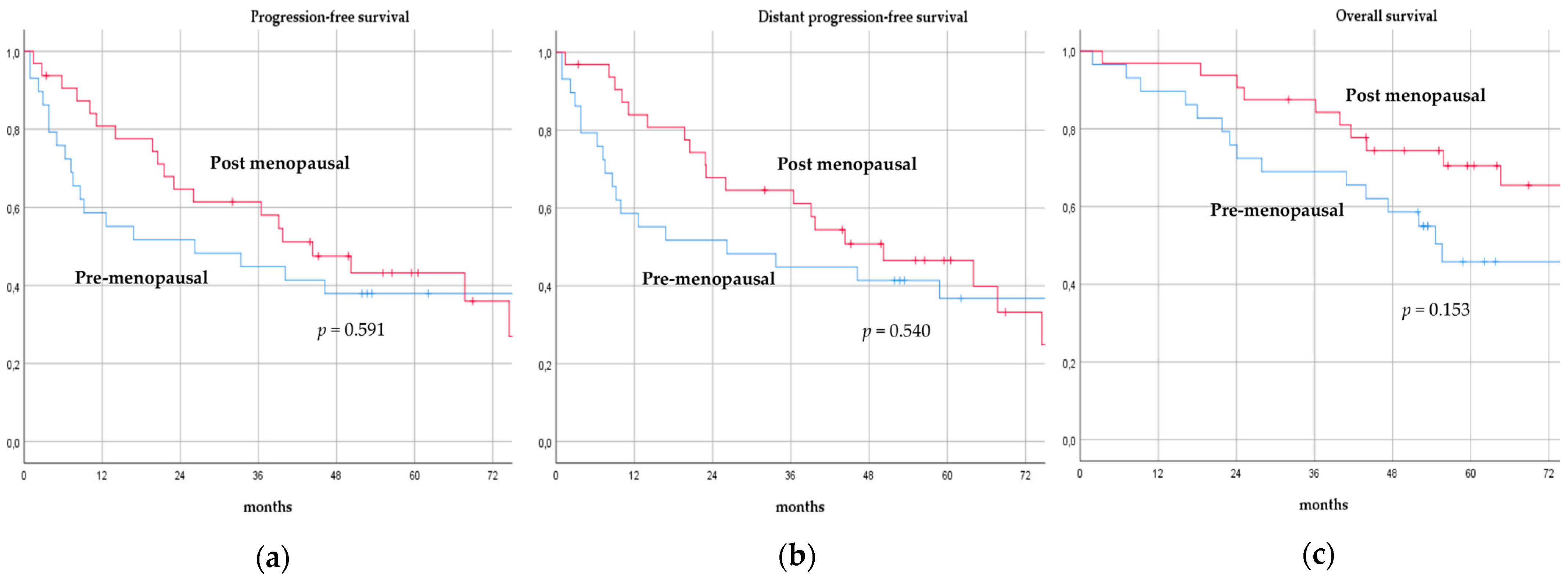
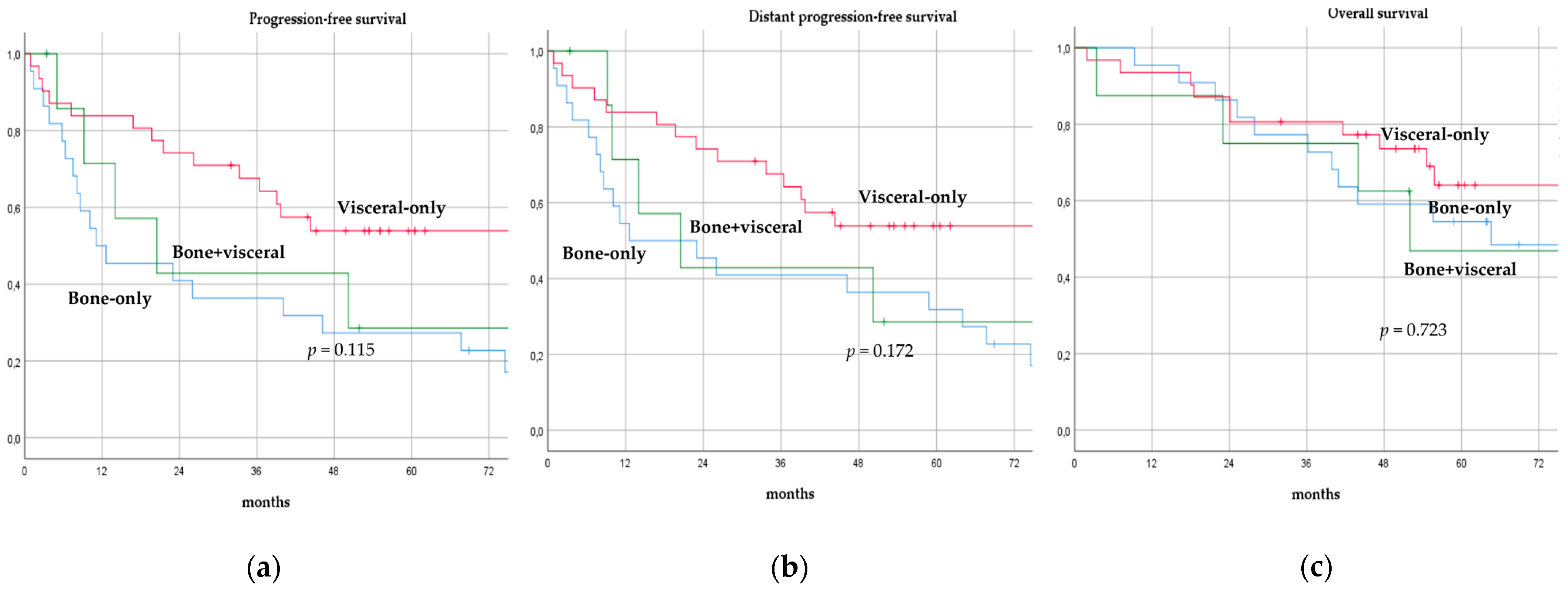
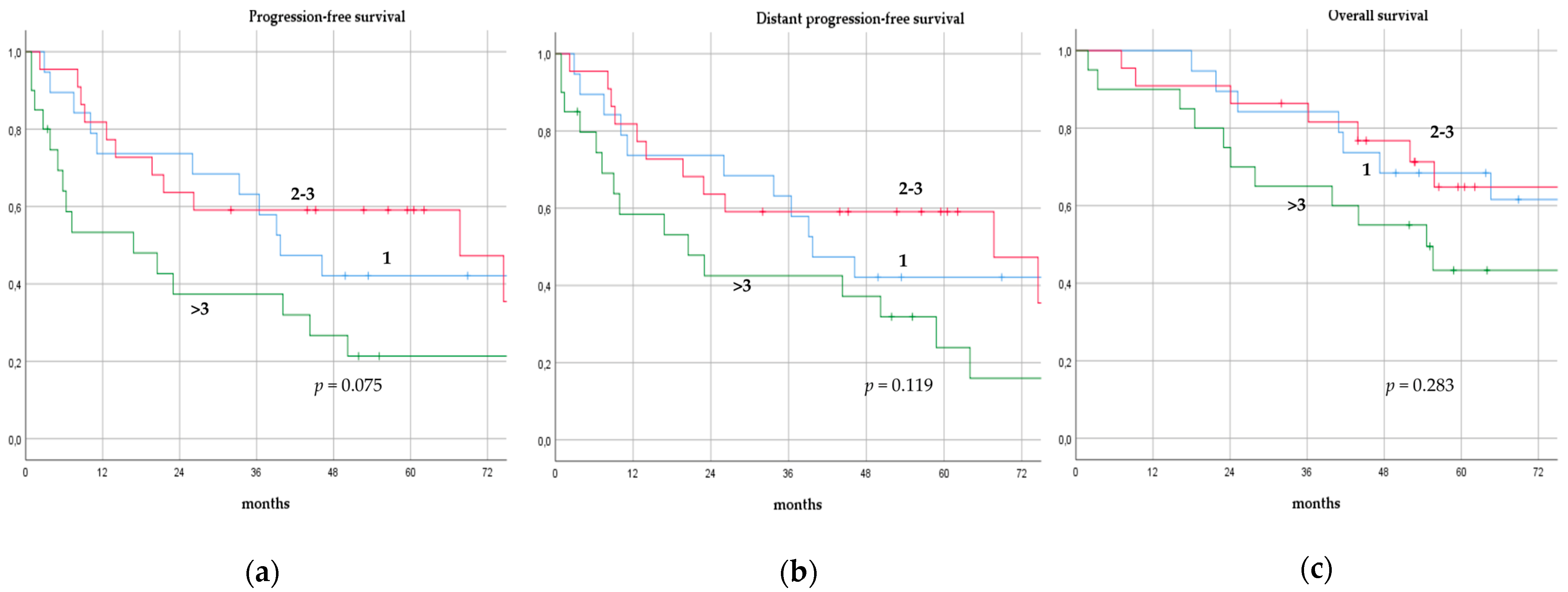
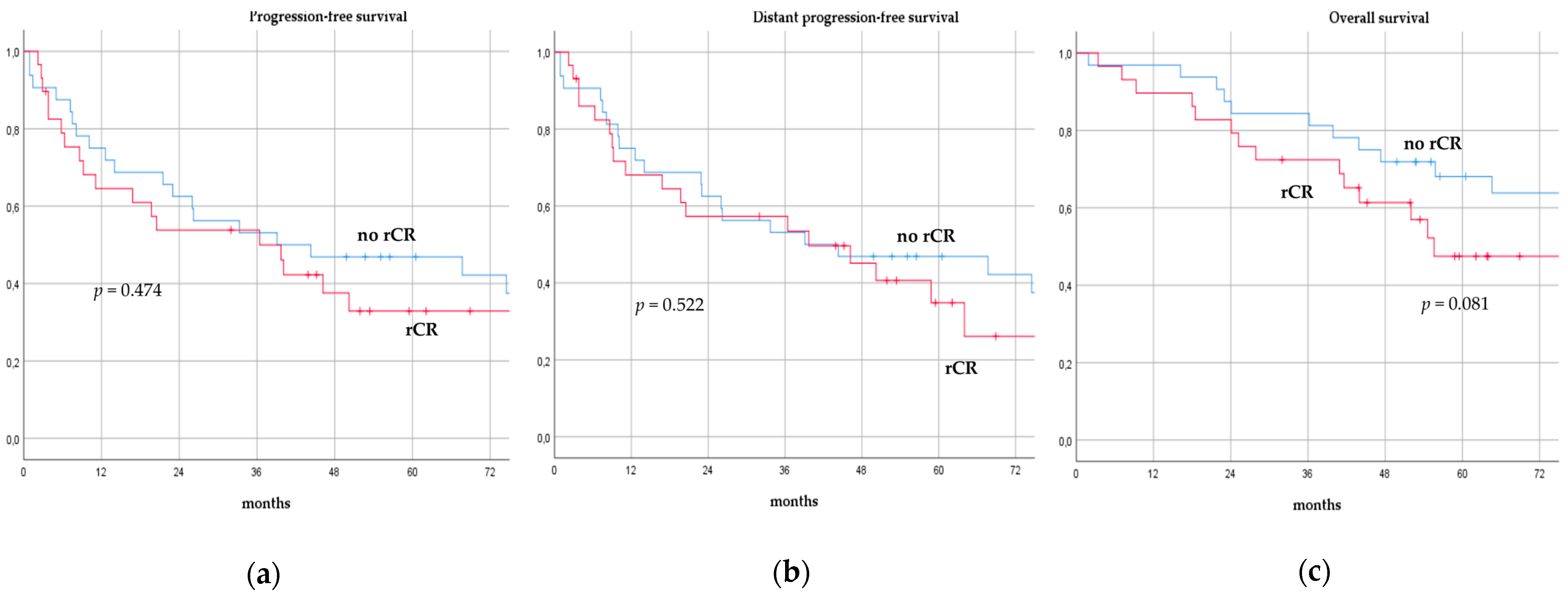
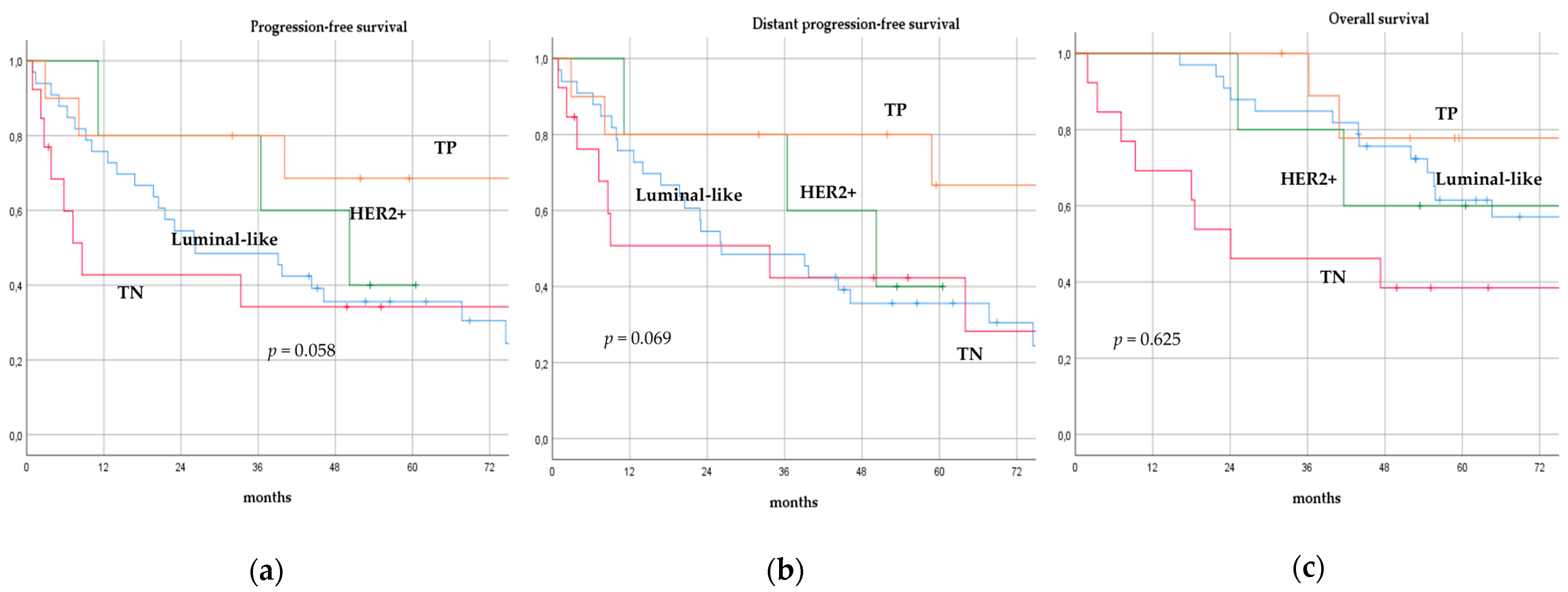
| Characteristics | Number (%)/Median (Range) |
|---|---|
| Patients | |
| Age (years) | 49 (30–82) |
| Post-menopausal | 32 (52.5%) |
| Radiological staging | |
| Mammography | 34 (55.7%) |
| Breast and axillary US | 61 (100%) |
| MRI | 19 (31.2%) |
| PET | 49 (80.3%) |
| Radionuclide bone scan | 16 (26.2%) |
| Pre-operative treatment | |
| - Anthracycline only | 24 (39.3%) |
| - Anthracycline and taxanes | 29 (47.5%) |
| - Trastuzumab | 16 (26.2%) |
| - Pertuzumab | 4 (6.6%) |
| - Hormone therapy | 15 (24.6%) |
| Breast cancer | |
| Single nodule | 46 (75.4%) |
| Dimension pre-FLC (mm) | 38 (10–82) |
| Stage pre-FLC | |
| - cT1 | 8 (13.1%) |
| - cT2 | 36 (59.0%) |
| - cT3 | 7 (11.5%) |
| - cT4 | 10 (16.4%) |
| - cN0 | 7 (11.5%) |
| - cN1 | 54 (88.5%) |
| Histotype | |
| - Ductal | 57 (93.4%) |
| - Lobular | 3 (4.9%) |
| - Mucinous | 1 (1.7%) |
| Stage post-FLC | |
| - ypT0 | 6 (9.8%) |
| - ypTis | 3 (4.9%) |
| - ypT1a | 4 (6.6%) |
| - ypT1b | 6 (9.8%) |
| - ypT1c | 11 (18.0%) |
| - ypT2 | 19 (31.2%) |
| - ypT3-4 | 12 (19.7%) |
| - Nx | 6 (9.8%) |
| - ypN0 | 22 (36.1%) |
| - ypN1a | 12 (19.7%) |
| - ypN2 | 13 (21.3%) |
| - ypN3 | 8 (13.1%) |
| Dimension post-FLC (mm) | 21 (0–81) |
| Biological sub-types | |
| - Luminal-like | 33 (54.1%) |
| - Triple-negative | 13 (21.3%) |
| - HER2-enriched | 5 (8.2%) |
| - Triple-positive | 10 (16.4%) |
| Ki67 (%) | 14 (2–90) |
| Lymphovascular invasion | 20 (32.8%) |
| Metastasis | |
| Radiologic complete response | 29 (47.5%) |
| Location | |
| - Visceral | 31 (50.8%) |
| - Bone | 22 (36.1%) |
| - Visceral and bone | 8 (13.1%) |
| Number | |
| - 1 | 19 (31.2%) |
| - 2–3 | 22 (36.1%) |
| - >3 | 20 (32.8%) |
| Loco-regional treatment | |
| Surgery | |
| - BCS | 24 (39.3%) |
| - Mastectomy | 37 (60.7%) |
| - ALND | 39 (63.9%) |
| Post-operative treatment | |
| - Loco-regional radiotherapy | 42 (68.9%) |
| - Hormone therapy | 43 (70.5%) |
| - Chemotherapy | 9 (14.8%) |
| - Trastuzumab | 15 (24.6%) |
| Subgroups | 5-Year PFS (95% CI) | 5-Year DPFS (95% CI) | 5-Year OS (95% CI) |
|---|---|---|---|
| Menopausal status | |||
| - Pre-menopausal | 37.9% (17.0–62.6) | 36.8% (20.2–63.3) | 45.8% (26.7–84.5) |
| - Post menopausal | 43.2% (27.6–61.0) | 46.5% (24.9–75.5) | 70.5% (64.2–140.8) |
| Biological sub-types | |||
| - Luminal-like | 35.6% (5.7–46.7) | 35.6% (7.3–45.1) | 61.5% (47.7–157.3) |
| - Triple-negative | 34.2% (4.0–43.2) | 42.3% (20.2–75.2) | 38.5% (36.4–58.5) |
| - HER2-enriched | 40.0% (20.6–79.8) | 40.0% (20.6–79.8) | 60.0% (56.4–148.5) |
| - Triple-positive | 68.6% (17.0–71.2) | 66.7% (20.2–69.3) | 77.8% (59.4–158.5) |
| Location | |||
| - Visceral | 53.9% (17.0–61.2) | 53.9% (20.2–59.3) | 64.1% (17.7–203.5) |
| - Bone | 27.3% (17.0–27.7) | 31.8% (20.2–40.9) | 54.5% (17.3–111.9) |
| - Visceral and bone | 28.6% (3.8–61.2) | 28.6% (3.8–37.2) | 46.9% (15.9–148.6) |
| Number | |||
| - 1 | 42.1% (25.8–53.6) | 42.1% (25.8–53.6) | 68.4% (48.2–156.9) |
| - 2–3 | 59.1% (13.7–121.7) | 59.1% (13.7–121.7) | 64.8% (56.4–148.6) |
| - >3 | 21.3% (17.0–61.2) | 23.9% (2.0–39.0) | 43.3% (32.6–76.6) |
| Radiologic response after FLC | |||
| - rCR | 32.9% (11.3–61.5) | 34.8% (6.4–73.0) | 47.5% (34.2–77.0) |
| - no rCR | 46.9% (17.0–90.2) | 46.9% (20.2–90.2) | 68.1% (65.6–206.8) |
Publisher’s Note: MDPI stays neutral with regard to jurisdictional claims in published maps and institutional affiliations. |
© 2022 by the authors. Licensee MDPI, Basel, Switzerland. This article is an open access article distributed under the terms and conditions of the Creative Commons Attribution (CC BY) license (https://creativecommons.org/licenses/by/4.0/).
Share and Cite
Tinterri, C.; Sagona, A.; Barbieri, E.; Di Maria Grimaldi, S.; Jacobs, F.; Zambelli, A.; Trimboli, R.M.; Bernardi, D.; Vinci, V.; Gentile, D. Loco-Regional Treatment of the Primary Tumor in De Novo Metastatic Breast Cancer Patients Undergoing Front-Line Chemotherapy. Cancers 2022, 14, 6237. https://doi.org/10.3390/cancers14246237
Tinterri C, Sagona A, Barbieri E, Di Maria Grimaldi S, Jacobs F, Zambelli A, Trimboli RM, Bernardi D, Vinci V, Gentile D. Loco-Regional Treatment of the Primary Tumor in De Novo Metastatic Breast Cancer Patients Undergoing Front-Line Chemotherapy. Cancers. 2022; 14(24):6237. https://doi.org/10.3390/cancers14246237
Chicago/Turabian StyleTinterri, Corrado, Andrea Sagona, Erika Barbieri, Simone Di Maria Grimaldi, Flavia Jacobs, Alberto Zambelli, Rubina Manuela Trimboli, Daniela Bernardi, Valeriano Vinci, and Damiano Gentile. 2022. "Loco-Regional Treatment of the Primary Tumor in De Novo Metastatic Breast Cancer Patients Undergoing Front-Line Chemotherapy" Cancers 14, no. 24: 6237. https://doi.org/10.3390/cancers14246237
APA StyleTinterri, C., Sagona, A., Barbieri, E., Di Maria Grimaldi, S., Jacobs, F., Zambelli, A., Trimboli, R. M., Bernardi, D., Vinci, V., & Gentile, D. (2022). Loco-Regional Treatment of the Primary Tumor in De Novo Metastatic Breast Cancer Patients Undergoing Front-Line Chemotherapy. Cancers, 14(24), 6237. https://doi.org/10.3390/cancers14246237








